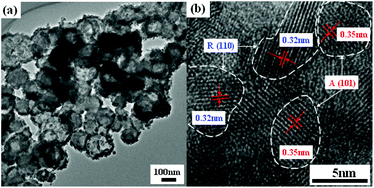Poly(allylamine hydrochloride) (PAAH), a mimic of biopolyamines, was used to induce the mineralization of titania at room-temperature, hollow spheres with a mixed phase (anatase and rutile) were obtained, and the fine anatase and rutile nanocrystals were observed mixing at the sub-10 nm scale on the hollow spheres. The structural information about the precipitated titania gained by transmission electron microscopy, X-ray diffraction, and X-ray photoelectron spectroscopy revealed a distinct dependence of the polymorph and morphology of the titania precipitates on the molecular structure of the polyamines and titanium precursors. Moreover, we have observed the phase transformation from anatase to rutile in the formation process of hollow spheres, and it was suggested that the protonated amino groups on PAAH played key roles in the transformation of both polymorphs and morphologies of titania. Additionally, poly(diallyldimethylammonium chloride) (PDDA), a long chain quaternary ammonium polymer, was used as another catalytic template for the synthesis of titania, which also led to a hollow structure with a mixture of anatase and TiO2-B.

You have access to this article
 Please wait while we load your content...
Something went wrong. Try again?
Please wait while we load your content...
Something went wrong. Try again?


 Please wait while we load your content...
Please wait while we load your content...